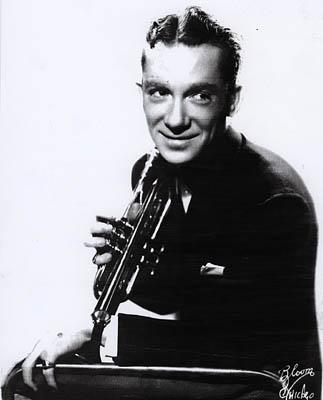Red Nichols (Ernest Loring Nichols)

Red Nichols was born on May 8, 1905 in Ogden, Utah, United States. His father was a college music professor, and Nichols was a child prodigy, because by twelve he was already playing difficult set pieces for his father’s brass band. Young Nichols heard the early recordings of the Original Dixieland Jazz Band, and later those of Bix Beiderbecke, and these had a strong influence on the young cornet player. His style became polished, clean and incisive. In the early 1920s, Nichols moved to the Midwest and joined a band called The Syncopating Seven. When that band broke up he joined the Johnny Johnson Orchestra and went with it to New York City in 1923. New York would remain his base for years thereafter. In New York he met and teamed up with trombonist Miff Mole, and the two of them were inseparable for the next decade. Prior to signing with Brunswick (see below), Nichols and Mole recorded a series of records for Pathé-Perfect under the name The Red Heads (whose final Red Heads records overlapped his signing to Brunswick). Red Nichols had good technique, could read music, and easily gained session and studio work. In 1926 he and Miff Mole began a prodigious stint of recording with a variety of bands, most of them known as “Red Nichols and His Five Pennies”. Very few of these groups were actually quintets; the name was simply a pun on “Nickel”, since there were “five pennies” in a nickel. “That was only a number we tied in with my name”, Nichols once explained. “We’d generally have eight or nine [musicians], depending on who was around for the session and what I was trying to do.”
Red Nichols recorded over 100 sides for the Brunswick label under that band name. He also recorded under a number of other names, among them, The Arkansas Travelers, The California Red Heads, The Louisiana Rhythm Kings, The Charleston Chasers, Red and Miff’s Stompers, and Miff Mole and His Little Molers. Some weeks, Nichols and his bands were making 10–12 records a week. His recordings of the late 1920s are regarded as the most progressive jazz of the period in both concept and execution, with wide-ranging harmonies and a balanced ensemble. However, they were small-band Dixieland groups, emphasizing collective improvisation and playing. They were different from Louis Armstrong’s Hot Fives of that period. Nichols’ band started out with Mole on trombone and Jimmy Dorsey on alto sax and clarinet. Other musicians who played for a time in his bands in the following decade were Benny Goodman (clarinet), Glenn Miller (trombone), Jack Teagarden (trombone), Pee Wee Russell (clarinet), Joe Venuti (violin), Eddie Lang (banjo and guitar), and Gene Krupa (drums). The Five Pennies’ version of “Ida, Sweet as Apple Cider” was a surprise hit record. It sold over one million copies, and was awarded a gold disc by the RIAA. Other labels Red Nichols recorded for included Edison 1926, Victor 1927, 1928, 1930, 1931 (individual sessions), Bluebird 1934, 1939, back to Brunswick for a session in 1934, Variety 1937, and finally OKeh in 1940.
Red Nichols kept himself alive during the first years of the Great Depression by playing in show bands and pit orchestras. He led Bob Hope’s orchestra for a while, moving out to California. Nichols had married Willa Stutsman, a “stunning” George White’s Scandals dancer, and they had a daughter. Their daughter came down with polio (misdiagnosed at first as spinal meningitis) in 1942, and Nichols quit a gig playing with Glen Gray and the Casa Loma Orchestra, leaving the music business to work in the wartime shipyards. On May 2, 1942, Nichols left his band to take an army commission, following completion of an engagement at Lantz’s Merry-Go-Round, Dayton, Ohio. Unable to stay away from music, Nichols formed a new Five Pennies band and began playing small clubs in the Los Angeles area soon after the war ended. Before long the word was out and musicians began showing up, turning his gigs into jam sessions.
Soon the little club dates were turning into more prestigious bookings at the chic Zebra Room, the Tudor Room of San Francisco’s Palace Hotel, and Pasadena’s posh Sheraton. He toured Europe as a goodwill ambassador for the State Department. Nichols and his band performed briefly, billed as themselves, in Quicksandb (1950), a crime film starring Mickey Rooney. In 1956 he was the subject of one of Ralph Edwards’ This Is Your Life television shows, which featured his old buddies Miff Mole, Phil Harris and Jimmy Dorsey, who praised Nichols as a bandleader who made sure everybody got paid. In 1965 Nichols took his Five Pennies band to Las Vegas, to play at the then-new Mint Hotel. He was only a few days into the date when, on June 28, 1965, he was sleeping in his suite and was awakened by paralyzing chest pains. He managed to call the front desk and an ambulance was summoned, but it arrived too late. That night the band went on as scheduled, but at the center of the band a spotlight pointed down at an empty chair in Nichols’ customary spot.
Born
- May, 08, 1905
- USA
- Ogden, Utah
Died
- June, 28, 1965
- USA
- Las Vegas, Nevada
Cemetery
- Forest Lawn Memorial Park (Hollywood Hills)
- Los Angeles, California
- USA


